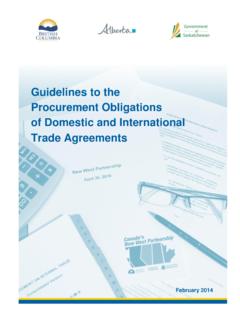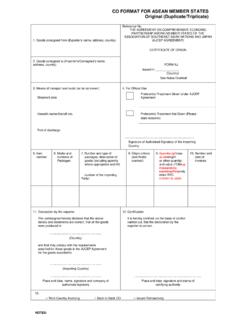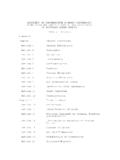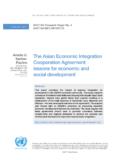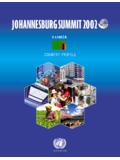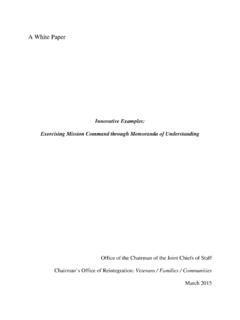Transcription of NEW WEST PARTNERSHIP TRADE AGREEMENT 2016
1 NEW west PARTNERSHIP TRADE AGREEMENT 2016 1 FOREWORD This document is a consolidation of the text of the original New west PARTNERSHIP TRADE AGREEMENT (2010) together with all Protocols of Amendment adopted since the signing of the AGREEMENT . Text Entry into force New west PARTNERSHIP TRADE AGREEMENT July 1, 2010 First Protocol of Amendment January 6, 2015 Second Protocol of Amendment December 31, 2016 Note to Readers: Article 21(3) of the AGREEMENT provides that the Parties may adopt Joint Decisions relating to the interpretation of the AGREEMENT . These Joint Decisions can be found on the AGREEMENT s website. i Contents PART I: OPERATING PRINCIPLES .. 1 PART II: .. 2 A. EXTENT OF OBLIGATIONS .. 2 Article 1: Relationship to the AGREEMENT on Internal TRADE .
2 2 Article 2: Scope and Coverage .. 2 B. GENERAL RULES .. 2 Article 3: No Obstacles .. 2 Article 4: Non-Discrimination .. 2 Article 5: Standards and Regulations .. 3 Article 6: Legitimate Objectives .. 3 Article 7: Transparency .. 4 Article 8: Exceptions .. 5 Article 9: Transitional Measures .. 5 C. SPECIAL PROVISIONS .. 5 Article 10: Purpose .. 5 Article 11: Investment .. 6 Article 12: Business Subsidies .. 6 Article 13: Labour Mobility .. 6 Article 14: Procurement .. 7 Article 15: Energy .. 8 Article 16: Transportation .. 9 PART III: ADMINISTRATIVE PROVISIONS .. 10 Article 17: Ministerial Committee .. 10 Article 18: Ministerial Committee Structure and Procedures .. 10 Article 19: Administrative Facilities .. 10 Article 20: Accession and Withdrawal.
3 11 Article 21: Further Negotiations and Joint Decisions .. 11 Article 22: Further Cooperation .. 11 Article 23: Entry Into Force .. 11 PART IV: DISPUTE 12 A. DISPUTE RESOLUTION MECHANISM .. 12 Article 24: Application .. 12 Article 25: Consultations .. 12 Article 26: Establishment of a Panel .. 14 ii Article 27: Panel Proceedings .. 15 Article 28: Implementation of Final Report .. 17 Article 29: Non-Implementation .. 17 Article 30: Determination of Monetary Awards .. 18 Article 31: Judicial Review .. 19 Article 32: Costs and Remuneration .. 19 Article 33: Abridgement or Extension of Time Periods .. 20 Article 34: Other Provisions .. 20 B. BID PROTEST MECHANISM .. 21 Article 35: Application .. 21 Article 36: Consultations .. 21 Article 37: Selection of Arbiter and Initiation of Proceedings.
4 22 Article 38: Bid Protest Proceedings .. 24 Article 39: Cost and Recoupment 25 Article 40: Enforcement of Awards .. 26 Article 41: Judicial Review .. 26 Article 42: Protection of Confidential Information .. 27 Article 43: Other Provisions .. 27 PART V: EXCEPTIONS .. 29 A. GENERAL EXCEPTIONS .. 29 B. BUSINESS SUBSIDIES .. 29 C. GOVERNMENT PROCUREMENT .. 30 D. ENERGY AND MINERALS .. 31 E. TRANSPORTATION .. 31 F. REGIONAL ECONOMIC DEVELOPMENT .. 31 G. FORESTS, FISH AND WILDLIFE .. 31 H. ENVIRONMENT .. 32 I. INVESTMENT .. 32 J. ENERGY .. 32 K. AGRICULTURE .. 32 L. ENERGY .. 33 M. TRANSPORTATION .. 33 N. AGRICULTURE .. 33 O. INVESTMENT .. 33 P. AGRICULTURE .. 34 Q. R. S. PART VI: DEFINITIONS .. 35 APPENDIX I TRANSITIONAL MEASURES (MANITOBA).
5 41 iii SCHEDULE 1 FORM OF CONSULTATION REQUEST UNDER ARTICE 25(2)..43 SCHEDULE 2 FORM OF CONSULTATION REQUEST UNDER ARTICLE 25(1) AND 25(4)..45 SCHEDULE 3 CRITERIA FOR THE APPOINTMENT OF POTENTIAL PANELLISTS AND ARBITERS ARTCILES 26(1) AND 37(1)..47 SCHEDULE 4 FORM OF CONSENT TO ARBITRATION ARTICLE 26(4)..48 SCHEDULE 5 REMUNERATION AND COSTS UNDER ARTICLE 32(5)..51 SCHEDULE 6 CODE OF CONDUCT FOR DISPUTE RESOLUTION PANELLISTS AND ARBITERS ARTICLES 26(8) AND 37(2)..55 SCHEDULE 7 FORM OF CONSENT TO ARBITRATION ARTICLE 37(4)..62 1 PART I: OPERATING PRINCIPLES The Governments of Manitoba, British Columbia, Alberta and Saskatchewan RESOLVED to: ESTABLISH a comprehensive AGREEMENT on TRADE , investment and labour mobility that applies to all sectors of the economy; ELIMINATE barriers that restrict or impair TRADE , investment or labour mobility; ENHANCE competitiveness, economic growth and stability; INCREASE opportunities and choice for workers, investors, consumers and businesses; REDUCE costs for consumers, businesses and governments; PROVIDE access to information to facilitate TRADE , investment and labour mobility; PROMOTE sustainable and environmentally sound development, and high levels of consumer protection, health and labour standards.
6 COOPERATE on matters related to TRADE , investment and labour mobility; MINIMIZE the impacts of other measures that may adversely affect TRADE , investment or labour mobility; RESOLVE disputes in an effective, inexpensive and timely manner; SUPPORT ongoing TRADE and investment liberalization both nationally and internationally; and DEMONSTRATE the benefits of freer TRADE within Canada by simplifying and expanding upon the scope and coverage of the AGREEMENT on Internal TRADE ; HEREBY AGREE as follows: 2 PART II: A. EXTENT OF OBLIGATIONS Article 1: Relationship to the AGREEMENT on Internal TRADE 1. This AGREEMENT is established pursuant to Article 1800 ( TRADE Enhancement Arrangements) of the AGREEMENT on Internal TRADE , which permits the Parties to enter into additional arrangements to liberalize TRADE , investment and labour mobility beyond the level required by that AGREEMENT .
7 2. In the event of an inconsistency between any provision in Parts II and V of this AGREEMENT and any provision of the AGREEMENT on Internal TRADE or any other AGREEMENT to which all Parties are signatories, the provision that is more conducive to liberalized TRADE , investment and labour mobility prevails among the Parties. In the event that such a provision of the AGREEMENT on Internal TRADE or any other AGREEMENT to which all Parties are signatories is determined to be more conducive to liberalized TRADE , investment and labour mobility, that provision is hereby incorporated into and made part of this AGREEMENT . Article 2: Scope and Coverage 1. This AGREEMENT applies to measures of the Parties and their government entities that relate to TRADE , investment and labour mobility.
8 2. Each Party is responsible for compliance with this AGREEMENT by its government entities. 3. The benefits of this AGREEMENT accrue only to the Parties and their persons. B. GENERAL RULES Article 3: No Obstacles 1. Each Party shall ensure that its measures do not operate to restrict or impair TRADE between, among or through the territory of the Parties, or investment or labour mobility between or among the Parties. Article 4: Non-Discrimination 1. Each Party shall accord to: 3 (a) like, directly competitive or substitutable goods; (b) persons; (c) services; and (d) investors or investments of the other Parties treatment no less favourable than the best treatment it accords, in like circumstances, to its own or those of any other Party or non-Party.
9 2. Each Party shall ensure that any charges it applies to persons, goods, services, investments or investors of the other Parties are the same as those charged to its own, in like circumstances, except to the extent that any difference can be justified by an actual cost-of-service differential. Article 5: Standards and Regulations 1. Parties shall mutually recognize or otherwise reconcile their existing standards and regulations that operate to restrict or impair TRADE , investment or labour mobility. 2. Parties shall, where appropriate and to the extent practicable, specify standards and regulations in terms of results, performance or competence. 3. Parties shall not establish new standards or regulations that operate to restrict or impair TRADE , investment or labour mobility.
10 4. Parties shall continue to work toward the enhancement of sustainable development, consumer and environmental protection, and health, safety and labour standards and the effectiveness of measures relating thereto. 5. Parties shall cooperate to minimize differences in standards or regulations adopted or maintained to achieve legitimate objectives. Article 6: Legitimate Objectives 1. A Party may adopt or maintain a measure that is inconsistent with Articles 3, 4 or 5, or Part II(C) provided the Party can demonstrate: (a) the purpose of the measure is to achieve a legitimate objective; (b) the measure is not more restrictive to TRADE , investment or labour mobility than necessary to achieve that legitimate objective; and (c) the measure is not a disguised restriction to TRADE , investment or labour mobility.

